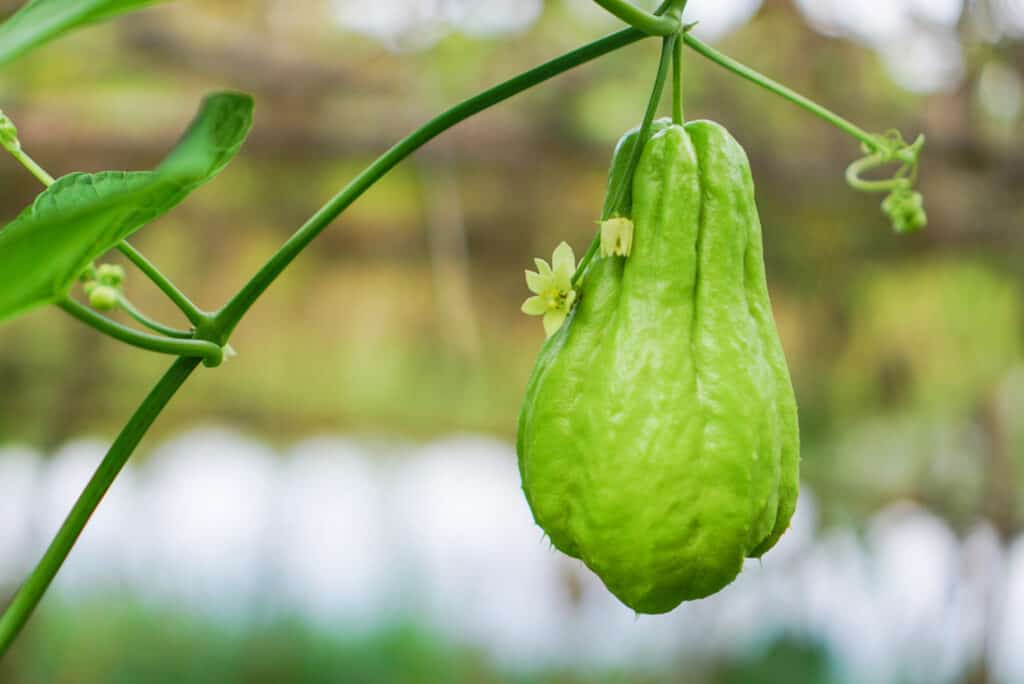Chayote is a warm-season, tender perennial. Plant the whole fruit 3 to 4 weeks after the last average frost date in spring when the weather has warmed. Chayote grows best where summer temperatures are very warm to hot, in tropical or subtropical regions. Chayote requires 120 to 150 frost-free days to reach harvest.
Here is your complete guide to growing chayote.

Chayote is a vine that produces a pale green to white, flattened-pear-shaped fruit that tastes like a nutty-flavored squash. Vine-like stems grow from a tuberous root and can reach up to 50 feet (15.2m) long. Leaves are hairy and resemble maple leaves; male and female flowers are borne on the same vine. Young shoots, fruit, and mature tubers are edible.
Yield. Plant 1 chayote vine per household of 4 persons.
Good Products At Amazon For Chayote Success:
Where to plant chayote
Plant chayote in full sun; chayote will grow in partial shade but the yield will be reduced. Grow chayote in loose, well-drained but moisture-retentive soil rich in organic matter. Chayote prefers a soil pH of 6.0 to 6.8.
When to plant chayote
Plant chayote 3 to 4 weeks after the last average frost date in spring when the soil temperature has reached at least 65°F (18°C). Chayote grows best where summer temperatures are warm to hot, in tropical or subtropical regions such as Florida, the Gulf Coast, and California. Chayote requires 120 to 150 frost-free warm days to reach harvest. In short-summer regions, grow chayote in a container so that it can be brought indoors when the temperatures cool.

Planting and spacing chayote
Set a whole chayote fruit about 4 to 6 inches (10-15cm)deep, fat end down, and at an angle so that the stem end is just level with the soil surface. Sow seeds or fruits 10 feet apart. Chayote is a vigorous climber; set a sturdy trellis or support in place at planting. Do not allow maturing fruit to come in contact with the soil; it will spoil and germinate while still attached to the vine.
Chaytoe companion plants
Plant chayote with pumpkins, peppers, squash, and corn. Do not grow chayote with celery, mint, or snap beans.
Container growing chayote
Chayote can be grown in a container, but the yield will not be significant. Grow chayote in a container about 24 inches deep. Chayote is a vigorous climber and a trellis or support should be set in the container at planting time.
Good Products at Amazon for Raised Bed Growing
- Galvanized Raised Bed 8×3
- Cedar Raised Bed 4×8
- Elevated Cedar Planter 4×2
- Walk-In Greenhouse Tunnel 15x7x7
- Row Cover for Freeze Protection 10×30
Watering and feeding chayote
Give chayote even, regular water; do not let the soil dry out. Add aged compost to the planting bed before planting. Side dress chayote with compost tea every 4 to 6 weeks during the growing season. Side dress chayote with aged compost at midseason.
Chayote care
Put a trellis or stake supports in place at planting time. In cold-winter regions, protect chayote with thick mulch 10 to 15 inches (25-38cm) thick before the first freeze.
Chayote pests and diseases
Pests: Aphids may attack chayote vines. Hand-pick or hose them off with a strong blast of water.
Diseases: Chayote has no serious disease problems.
Harvesting chayote
Chayote will be ready for harvest when the fruit is tender and about 4 to 6 inches (10-15cm) in diameter, usually 120 to 150 warm, frost-free days after planting. Cut chayote from the vine with a knife or hand-pruner. Harvest chayote before the flesh gets hard.
See How to Cook and Serve Chayote
Storing and preserving chayote
Chayote will keep in the refrigerator for up to 1 week. Diced chayote can be frozen or canned for up to 1 year.
Chayote varieties to grow
Plant the whole seed or whole vegetable of any variety available. Check with the area cooperative extension or nearby nursery for regional availability.
About chayote
Common name. Chayote, chocho, chuchu, sou-sou, vegetable pear, one-seeded cucumber
Botanical name. Sechium edule
Origin. Central America
More how to grow articles:
Learn how to plant, grow, and harvest your favorite vegetables. Click below for all you need to know.
- Artichoke
- Arugula
- Asparagus
- Beans, Snap
- Beets
- Broad Beans
- Broccoli
- Brussels Sprouts
- Cabbage
- Cantaloupe — Melons
- Cardoon
- Carrots
- Cauliflower
- Celeriac
- Celery
- Chard
- Chayote Squash
- Chickpeas
- Chicory
- Chinese Cabbage
- Collards
- Corn Salad
- Corn, Sweet
- Cresses
- Cucumbers
- Eggplant
- Endive and Escarole
- Fava Beans
- Florence Fennel
- Garbanzo Beans
- Garlic
- Horseradish
- Jerusalem Artichoke
- Kale
- Kohlrabi
- Leeks
- Lettuce
- Lima Beans
- Melons
- Mizuna
- Mustard Greens
- New Zealand Spinach
- Okra
- Onions
- Parsnips
- Peanuts
- Peas
- Peppers
- Potatoes
- Pumpkins
- Radicchio
- Radishes
- Rhubarb
- Rutabaga
- Salsify
- Shallots
- Sorrel
- Southern Peas
- Soybeans
- Spinach
- Squash, Summer
- Squash, Winter
- Sunchokes
- Sweet Potato
- Swiss Chard
- Taro
- Tomatillo
- Tomatoes
- Turnips
- Watermelon
- Zucchini
Related articles:
Planning the Home Fruit Garden
Garden Planning Books at Amazon:
- Vegetable Garden Almanac & Planner
- Kitchen Garden Grower’s Guide Vegetable Encyclopedia
- Vegetable Garden Grower’s Guide
- Tomato Grower’s Answer Book
















